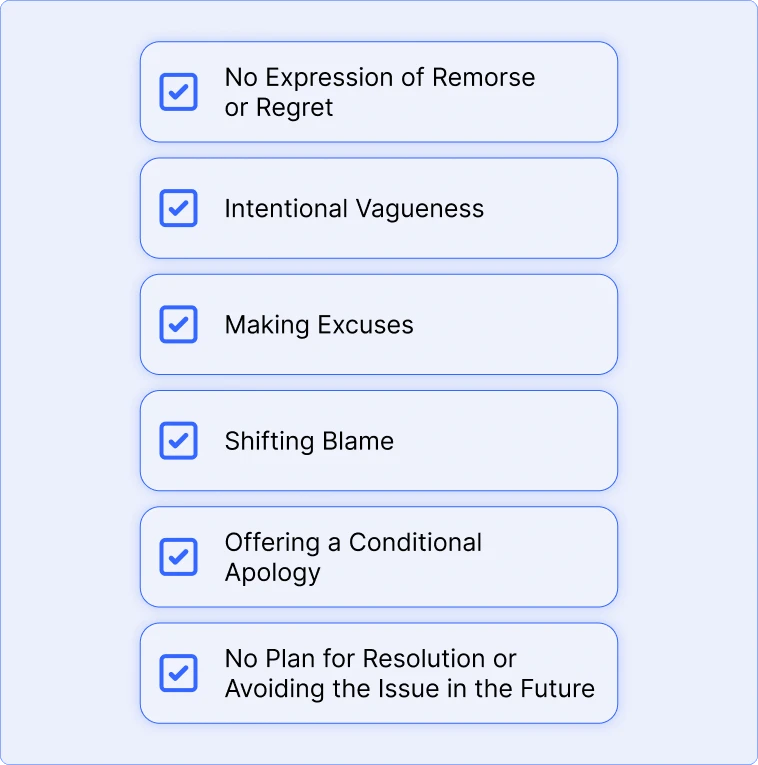How to Write an Apology Letter to Customer [ 24 Templates, Mistakes & Tips ]
- May 19, 2024
- 25 mins read
- Listen

Few moments are as challenging for a business as realizing a customer has had a negative experience. Whether it’s a delayed shipment, a recurring issue, or an interaction that fell short of respectful, these customer pain points don’t just affect your business reputation—they leave customers feeling undervalued and frustrated.
The reality is that mistakes happen, but how you handle them can make all the difference in repairing the relationship and restoring trust. Writing a thoughtful, sincere apology letter to customer can be a powerful tool in bridging these gaps. But, how to do that? Let’s find it.
How to Write an Apology Letter to a Customer?

When you are going to write an apology letter to a customer, it’s crucial to begin with a sincere expression of regret. You have to take full responsibility for the mistake or issue and provide a brief and accurate explanation of what went wrong. Now let’s take a look at some key procedures for how to write an apology letter to the customer.
Do’s:
- Begin by acknowledging the specific issue the customer experienced.
- Accept responsibility for the mistake without deflecting or blaming others.
- Use sincere language to show you genuinely regret the inconvenience caused.
- Briefly explain the reason for the issue to add transparency, but only if it’s appropriate.
- Describe how you’re fixing the issue and what steps you’ve taken to prevent it in the future.
- Offer a discount, refund, or other compensation when relevant to restore goodwill.
- Encourage the customer to reach out if they have further questions or concerns.
- Conclude with a positive note, expressing your commitment to better service in the future.
Dont’s:
- Don’t use vague or impersonal language—make the apology specific to the customer’s situation.
- Never imply that the customer might be at fault for the issue.
- Don’t go into unnecessary detail that may come across as making excuses.
- Only promise what you can deliver to avoid further disappointment.
- Send the apology as soon as possible to show you prioritize the customer’s experience.
1. Begin With a Sincere Apology
Don’t be fake. You need to begin your letter by expressing genuine regret for the inconvenience or problem caused to the customer. Plus, make sure that you’re using sincere language to convey your apology. Also, you should acknowledge the impact of the issue on the customer’s experience with your business.
2. Accept Responsibility for the Mistake or Issue
You have to take responsibility for the mistake or problem without making excuses. It demonstrates accountability and shows the customer that you are committed to addressing the issue.
3. Explain the Situation Briefly and Accurately
There is no better remedy than a brief explanation of a situation that caused inconvenience. You should always try to clearly and concisely explain what went wrong.
So, if any inconvenience happens, you need to describe the circumstances surrounding the mistake or issue. Moreover, avoid unnecessary details that may confuse the customer.
4. Express Empathy and Understanding of the Customer’s Perspective
Always show empathy towards the customer. You should always make sure that you’re acknowledging their feelings and understanding the impact of the problem on their experience.
You can use empathetic language to convey your understanding of customer frustration or disappointment. Also, you’ll have to assure them that their concerns are valid and important to you.
5. Provide Details About How the Issue Will Be Resolved or Addressed
It is another effective approach you can follow to write an apology letter to the customer. You need to outline the steps you will take. It will rectify the situation and prevent similar issues from occurring in the future.
Be specific about the actions you will take to address the customer’s concerns. And ensure their satisfaction. It is obvious to provide timelines or deadlines. If applicable, and offer compensation or solutions as appropriate to make amends for the inconvenience caused.
6. Offer Compensation or a Solution to Make Amends, if Applicable
If the situation warrants it, you need to offer the customer compensation. Also, you can provide a solution to rectify the issue. Plus, make amends for any inconvenience caused. This could include refunds, discounts on future purchases, free products or services, or any other gesture. These demonstrate your commitment to customer satisfaction.
7. Assure the Customer That Steps Will Be Taken to Prevent Similar Issues in the Future
It is crucial to make the customer happy. You need to ensure you’re taking customer feedback seriously. You are implementing measures to prevent similar issues from occurring in the future. This helps to restore their confidence in your business. This demonstrates your commitment to continuous improvement.
8. Maintain a Professional and Courteous Tone Throughout the Letter
It’s essential to maintain a professional and courteous tone in your apology letter. You always have to convey respect and sincerity. Of course, you must avoid using defensive language or placing blame on the customer. You can focus on expressing empathy and a genuine desire to resolve the issue.
9. Keep the Letter Concise and to the Point
While it’s important to address the issue thoroughly. It’s also crucial to keep the letter concise and to the point. Don’t include unnecessary details or information. It may distract from the main message of the apology.
10. Thank the Customer for Their Understanding and Continued Patronage
You should never miss the opportunity to express gratitude to the customer for their understanding and continued support of your business. Don’t forget to thank them for their patronage. Undoubtedly, it reinforces the positive relationship between your business and the customer.
24 Apology Letter to Customer Templates
Let’s find the 20 apology letter examples and templates of apology letters that are carefully crafted to help businesses effectively address customer concerns and rebuild trust. So, what are you waiting for? Let’s explore.
1. Product or Service Quality Issues
2. Delays in Delivery or Service
3. Billing Errors
4. Miscommunication With the Customer
5. Customer Dissatisfaction With Staff Behavior
6. Inconvenience Caused to the Customer
7. Failure to Meet Customer Expectations
8. Accidental Damage to Customer Property
9. Out-of-stock Situations
10. Technical Issues Affecting Service
11. Inaccurate Information Provided to the Customer
12. Overbooking or Double-booking
13. Breach of Contract
14. Safety or Security Concerns
15. Regulatory or Compliance Violations
16. Errors in Promotional Materials
17. Dissatisfaction With the Outcome of a Service or Resolution Process
18. Issues With Warranty Claims or Repairs
19. Unavailability of a Requested Product or Service
20. Problems With Accessibility for Customers With Disabilities
21. Apology letter for unresolved issues
22. Apology letter for recurring issues.
23. Apology Letter for Undelivered Email
24. Apology Letter to Customer for Being Rude
Common Apology Letter Mistakes
We all make mistakes! Sometimes it turns counter initiative and creates an unpleasant situation. Do you know what are the common mistakes in creating an apology letter? Well, let’s find the most common mistakes to avoid to craft a win-win apology letter.
1. No Expression of Remorse or Regret
It’s essential to begin an apology letter with a sincere expression of remorse or regret. For the inconvenience or problem caused. If you fail to convey genuine regret. It can make the apology seem insincere and undermine efforts to rebuild trust with the customer.
So, you have to ensure that your apology comes across as heartfelt and sincere to effectively address this mistake.
2. Intentional Vagueness
When explaining the situation in an apology letter. It’s crucial to be transparent and specific about what went wrong. Your intentional vagueness can leave customers feeling confused or distrustful.
They may perceive it as an attempt to avoid accountability. You should provide clear and concise details about the issue. Also, you need to demonstrate transparency and honesty.
3. Making Excuses
In your apology letter to the customer, don’t make excuses or justify the mistake in an apology letter. Your customers appreciate accountability. Making excuses can come across as deflecting blame rather than taking ownership of the error. Instead, focus on accepting responsibility and acknowledging the impact of the mistake on the customer.
4. Shifting Blame
Similarly, avoid shifting blame onto external factors or other parties in your apology letter. Undeniably, blaming others can appear defensive and insincere. Mostly, it detracts from the main purpose of the apology.
So, you need to address the customer’s concerns and rebuild trust. It is ideal to take ownership of the mistake and focus on finding a resolution.
5. Offering a Conditional Apology
It is one of the key steps to writing an apology letter to the customer. Remember, an apology should be unconditional and not contingent upon certain conditions being met by the customer.
Your conditional letter can invalidate the sincerity of the apology and make it seem insincere. You need to make sure that your apology is genuine and unconditional.
6. No Plan for Resolution or Avoiding the Issue in the Future
It’s crucial to outline concrete steps for resolving the issue. It plays a key role to prevent similar issues from occurring in the future. If you fail to provide a resolution plan or avoid the issue. It can leave customers feeling uncertain about the reliability of your business.
You should focus on your commitment to addressing the issue. You can explain the actions you will take to rectify the situation and prevent it from happening again.
Standard Apology Letter Format
Dear Julie,
I am writing to sincerely apologize for missing our meeting on Monday. I understand that it was my responsibility to keep track of our appointments and ensure I was there on time. I deeply regret any inconvenience and frustration my absence caused you.
I can imagine how disappointing and upsetting it was to have me miss the meeting, especially after you had set aside time for it. I had an unexpected personal emergency that I should have communicated to you about sooner.
I would like to reschedule the meeting at a time that is convenient for you, and I assure you that I will be there without fail. In the future, I will set multiple reminders and communicate promptly if any issues arise.
Thank you for your understanding, and I hope we can move forward positively from this.
Sincerely,
Joe
10 Tips to Write an Apology Letter to Customer
Do you know writing an empathetic apology letter is crucial to show genuine empathy when an unwanted situation happens? But, how to do that? What do you have to focus on? It requires understanding and addressing the feelings of the person you are apologizing to. Now let’s find some essential tips to help you craft an effective and sincere apology letter:
1. Acknowledging the Mistake
First and foremost, you need to be upfront about the mistake you made. It’s vital to clearly state what went wrong. You can show that you fully grasp the issue. You need to be clear, and concise. Instead of saying something like, “I’m sorry for what happened,” try something along the lines of, “I apologize for missing our Monday meeting.”
2. Taking Responsibility
It is pivotal to write an apology letter. You must own up to your actions without making excuses or shifting the blame onto others. This demonstrates maturity and accountability. For example, you can say, “I understand that it was my responsibility to keep track of our appointment and ensure I was there on time.”
3. Expressing Genuine Remorse
You’ll have to convey your sincere regret and show that you understand the impact your actions had on the other person. This step is crucial for demonstrating your sincerity. You could write something like, “I deeply regret any inconvenience and frustration my absence caused you.”
4. Showing Empathy
Undoubtedly, empathy is key. You’ll have to acknowledge the feelings and experiences of the person you are apologizing to. When you demonstrate empathy, it helps the other person feel understood and respected. A suitable way to express this is, “I can imagine how disappointing and upsetting it must have been for you to have me miss the meeting, especially after you had set aside time for it.”
5. Explaining What Happened (If Appropriate)
If there are relevant circumstances that led to the mistake, briefly explain them. Don’t claim your statement that you were right. However, be cautious not to use this as an opportunity to make excuses. For instance, you could say, “I had an unexpected personal emergency that I should have communicated to you about sooner.”
6. Offering a Solution or Making Amends
When anything is caused, we all need immediate solutions. So, you have to propose a way to make up for your mistake or detail how you plan to avoid repeating it in the future. This shows that you are proactive and committed to correcting your errors. For instance, you might say, “I would like to reschedule the meeting at a time that works for you, and I assure you that I will be there without fail.”
7. Promising to Do Better
You cannot deny the fact that genuine commitment breaks the ice and builds trust. You need to commit to taking specific steps to prevent the same mistake from happening again. This demonstrates your dedication to improvement. For example, you can write, “In the future, I will set multiple reminders and promptly communicate if any issues arise.”
8. Keeping It Concise
Use simple words and simple sentences. You need to make sure that your letter is clear, to the point, and covers all the necessary elements. However, lengthy explanations can dilute the impact of your apology.
9. Ending on a Positive Note
Conclude your letter positively. You should express gratitude or hope for forgiveness and improved future interactions. This leaves a good impression and sets the stage for moving forward. For instance, thank you for your understanding, and I genuinely hope we can move forward positively from this.
10. Proofreading
Finally, you need to be cautious while sending your apology letter. Don’t forget to proofread thoroughly to avoid any errors. Remember, a well-written letter reflects professionalism and sincerity, which are essential for effective communication.
Conclusion
Writing an apology letter to a customer is not just about admitting fault. It’s about demonstrating genuine care, empathy, and commitment to making things right. Remember, a well-written apology letter to a customer can turn a negative experience into an opportunity for stronger customer relationships and loyalty.
So, don’t hesitate to reach out and apologize when needed. Your customers will appreciate your honesty and dedication to their satisfaction.
Frequently Asked Questions
Begin with a sincere apology, take responsibility, briefly explain the issue (if needed), provide a solution, and end on a positive note of commitment to improvement.
We’re truly sorry for the inconvenience caused. We value your satisfaction and are working to resolve this for you quickly. Thank you for your patience.
Dear [Customer Name], we apologize for the service you received that didn’t meet our standards. We’re addressing this to ensure a better experience moving forward. Thank you for your feedback.
Use polite, empathetic language, acknowledge the issue, express regret, offer a solution or next steps, and maintain a positive, appreciative tone.
We apologize sincerely for any inconvenience caused. Your satisfaction is our priority, and we’re committed to making things right.
Address the customer by name, clearly state the issue, take full responsibility, show empathy, explain any corrective actions, and invite them to reach out with further concerns. You should end with a positive statement of commitment.








